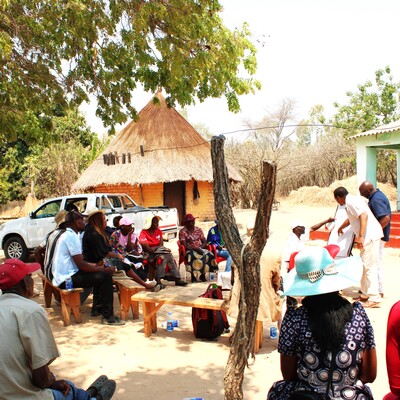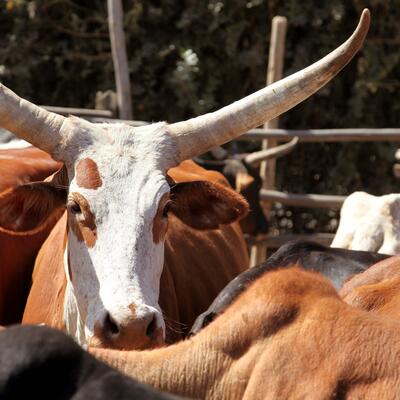
How closing livestock yield gaps can enhance incomes, food security and the environment in Ethiopia and India

Understanding livestock yield gaps for poverty alleviation, food security and the environment is a report published by the LiveGAPS Project, funded by the Bill and Melinda Gates Foundation (BMGF), in Dec 2016. The report was written by Mario Herrero (Commonwealth Scientific and Industrial Research Organisation [CSIRO]), Di Mayberry (CSIRO), Jeannette van de Steeg (research consultant), David Phelan (University of Tasmania), Andrew Ash (CSIRO), Kanar Diyezee (CSIRO), Tim Robinson (ILRI), Ben Henderson (CSIRO), Marius Gilbert (Leuven University), Mark van Wijk (ILRI), Cecile Godde (CSIRO), Michael Blummel (ILRI), Di Prestwidge (CSIRO), Elle Stephenson (CSIRO), Brendan Power (CSIRO) and David Parsons (University of Tasmania).
From the Executive Summary
‘The BMGF and other donors and development agencies need to target investments in the livestock sector in ways that are likely to maximize the impacts for broad numbers of producers and consumers. Estimating and understanding how to measure and trigger productivity changes in livestock systems is essential for better defining the technological and investment needs in the livestock sector.
Estimates of livestock yield gaps are not available and these are necessary for developing feasible scenarios of how the production of different livestock commodities might evolve in the future, how systems might change and what would be the resource use implications and their costs, both for donors and for public and private entities in target countries.
Productivity and yield gap analyses will also help define the most appropriate technology entry points for different livestock species: health, nutrition, genetics, policy levers, others.
This information will contribute to making informed investment decisions and target technologies in the livestock sectors of developing countries.
From Main Findings
‘1. DAIRY: Our study suggests that dairy yield gaps in Ethiopia and India range between 65-350% depending on the type of intervention package implemented. In both cases, benchmarking production against the top 10% of producers demonstrated that yields could be tripled. However, when implementing efficiency frontier studies, we found that potentially more modest gains would be achievable at the herd level.
‘2. DAIRY: Our projections demonstrate that it would be possible to increase production further that the existing baseline projections to 2030 for India and Ethiopia would suggest. For example, dairy production in India is projected to increase by a factor of 65% to 2030. Our results show that with improved feeding and promoting changes in the herd structure towards more cross-breeding and or buffalo production, milk production could increase between 112-130% by 2030.
‘3. DAIRY: Ethiopia has higher yield gaps than India, but also as a result of a lower baseline. Ethiopian dairy production is expected to grow by 84% to 2030 under baseline conditions. Alternative scenarios demonstrated a positive, but more variable production response, ranging from 97-242% depending on the improvement strategy selected. Packages of interventions including better feeding, crossbreds and others led to the highest potential gains. These results were confirmed by our benchmarking studies.
‘4. MARKET ACCESS: A very strong and statistically significant link between market access and farm performance was found for most sites. This suggests that efforts to improve market access should be an important component of policies to close yield gaps.
‘5. BIOMASS: Biomass constraints could be critical for the development of the ruminant livestock sector in India and Ethiopia. In these situations achieving production targets with less, more productive animals might be desirable.
‘6. MILK: Increasing milk production will require both an increase in the quantity of feed available and more efficient use of existing resources. This is especially important as the smaller indigenous livestock breeds are replaced by larger crossbred cattle and buffalo with higher energy requirements.
‘7. DRAUGHT POWER: A shift away from the use of cattle and buffalo for draught purposes will make more feed resources available for dairy production in India. However, a decrease in the total size of the national dairy herd may still be required to increase total production.
‘8. CROSS-BREEDING: Cross-breeding is a good option to increase milk productivity, but this will only work if higher quality feed is available.
‘9. HERD MANAGEMENT: Herd management and species composition for milk production is a key strategy to maximize milk production in India.
’10. SMALL RUMINANTS: There is significant potential for increasing small ruminant production through practices to reduce mortality and strategic sowing of improved fodders. Cross-breeding in these systems was shown to be relatively ineffective, but a package with the three interventions demonstrated to have the potential to increase productivity five-fold. These results translated in a potential doubling of small ruminant meat production to 2030 relative to 2010.
’11. ANIMAL NUTRITION: The interactions between improved nutrition and improved reproduction and reduced mortality could be used as a way of increasing total system productivity while protecting livestock assets.
’12. FEEDS: The most profitable feeding interventions tested are not necessarily those with the highest productivity. This needs to be accounted for when designing dairy improvement programmes.
’13. INTERVENTION PACKAGES: In all cases and for all species and location, packages of interventions performed better than single interventions for increasing productivity and profitability of livestock production.
’14. POULTRY: The smallholder poultry sector in Ethiopia could potential supply a significant amount of meat and eggs, especially if improved interventions are applied. In contrast, the strength and the accelerated growth of the industrial poultry sector in India is likely to dominate poultry production in the next 20 years. Nevertheless, localised livelihoods benefits of improved extensive poultry production are likely to be continue to be important in places.
’15. POULTRY: Ethiopia: The regional mean annual egg offtake for a small sized farm for the baseline was 21.7 eggs. The largest increases in regional egg offtake rates were from the dual interventions of vaccination and supplementary feeding (48.4) and crossbreeding and housing (46.2).
’16. VACCINES & FEEDS & HOUSING: The dual intervention of vaccination and supplementary feeding consistently returned the greatest percentage increase in net profits above the baseline value for each of the different sized farms. However, the cost of providing supplementary feed can be highly variable, dependent on many localized issues. The dual intervention of vaccination and housing frequently provided the greatest increases concerning total bird offtake rates, however the percentage increase in net profits as a result of this intervention was relatively much lower, due to the cost associated with providing daytime housing.
’17. VALUE CHAINS: Market incentives and value chain development will be essential to ensure farmers can intensify their production.
’18. FEED MANAGEMENT: Investment in projects targeting improved feed management should be a priority. Without these, the impacts of many other interventions (genetics, health) will be small. This should include fodder markets and biomass value chains, apart from on-farm interventions on improved fodders.
’19. HERD MANAGEMENT: Further research on herd management and manipulation of herd structures is necessary.
From the Introduction (omitting references)
‘Livestock play a significant role in rural livelihoods and the economies of developing countries. They are providers of income and employment for 1.3 billion producers and others working in, sometimes complex, value chains. They are a crucial asset and safety net for the poor, especially for women and pastoralist groups, and they provide an important source of nourishment for billions of rural and urban households. These socio-economic roles and others, are increasing in importance as the sector grows due to increasing human population, incomes, and urbanisation rates.
‘The demand for livestock products in developing countries is projected to double in the next forty years as a result of the drivers mentioned above. There is a need to ensure that the smallholder sector is able to respond to sustainably supply the volumes of livestock products required to meet the increased consumption, thus increasing their incomes, protecting their assets and consuming wholesome diets. We need a sustainable livestock revolution in action. Therefore, understanding how the contribution of smallholders livestock farmers might evolve in the future is needed for better implementing poverty reduction and nutritional security strategies.
The developing world produces 41% of the milk, 72% of the lamb, 50% of the beef, 59% of the pork and 53% of the poultry globally.
These shares are likely to increase significantly to 2050 as rates of growth of livestock production in the developing world exceed those in developed countries (>2%/yr and <1% /yr, respectively).
Mixed extensive and intensive crop-livestock systems produce 65%, 75% and 55% of the bovine meat, milk and lamb, respectively, of the developing world share.
‘The productivity of livestock in the developing world is low, relative to its potential. There are significant opportunities to increase it via adequate mixtures of technologies, policies and investments in farms and product value chains. However, until recently, the baseline data needed to adequately characterize livestock productivity levels in different parts of the developing world was either not available, nor at the level of disaggregation necessary to make informed decisions on the upscaling potential of key interventions and their impacts on productivity and household nutrition and income. This is quickly changing due to new data sources but there is a significant need to study and synthesize the potential for productivity increases in smallholders systems for improved programmatic decision making and for targeting poverty and food security strategies.
‘The BMGF and other donors and development agencies need to target investments in the livestock sector in ways that are likely to maximize the impacts for broad numbers of producers and consumers. Estimating and understanding how to measure and trigger productivity changes in livestock systems is essential for better defining the technological and investment needs in the livestock sector. . . .
From the Terms of Reference
This one-year investment, commissioned to CSIRO in partnership with ILRI and UTAS, and codeveloped with the BMGF Livestock Programme, aimed to:
‘1. Improve the existing livestock baseline productivity data in selected BMGF target countries and in Sub-Saharan Africa and South Asia in general. We developed a framework for assessing productivity in livestock systems, particularly those owned and managed by smallholder farmers. Part of this work included updating existing productivity maps for dairy, small ruminant (milk and meat) and poultry (eggs, poultry) for the year 2000 to the year 2010 for the specific countries and continents. We used new information from surveys and livestock monitoring systems for improving this effort. Additionally we updated the distributions of animal numbers and the share of smallholder production as part of this effort for regional level assessments, while at the farm level we used household-level analysis for estimating the productivity of dairy, small ruminants and poultry. This enabled us to determine baseline hotspots of production, shares by production system, feed demand and supply and contribution of livestock to livelihoods in the regions of interest.
‘2. As a second step, using state of the art livestock and household simulation models like CSIRO’s IAT, RUMINANT, APSFARM and other models from partners, we estimated the impacts of best bet packages of interventions provided by key informants (genetics, nutrition, health) on livestock productivity, and farmers’ incomes and nutrition in different types of production systems in two selected BMGF target countries (India and Ethiopia). This is a practical way of getting a better sense of how to exploit yield gaps in these systems, rather than assessing technical potentials. Additionally this can lead to a prioritization of key interventions in terms of production potential, costs and others.
‘3. The study would also assess the potential impacts of these practices if they were up-scaled broadly throughout the individual countries to 2017 and 2030. This kind of information would enable BMGF to assess the feasibility and investment needs of selected practices and would enable us to assess country level impacts on consumption of livestock products and farmers’ incomes.
‘4. Additionally, the project would develop a dissemination portal for the data and would organize a small workshop for setting the foundations for establishing a community of practice in the field of livestock modeling and data sharing. . . .’

















